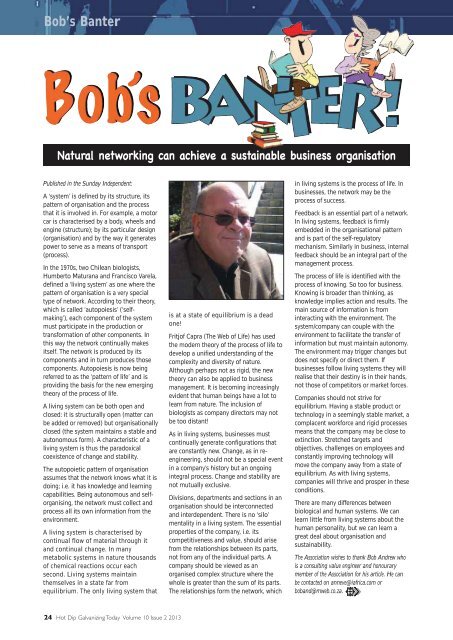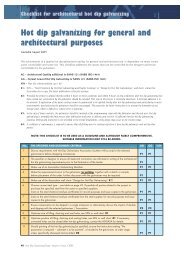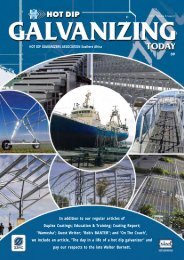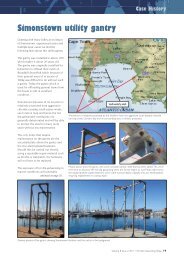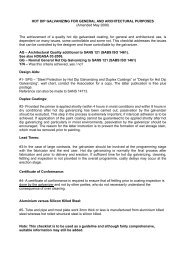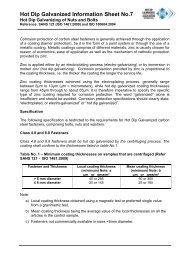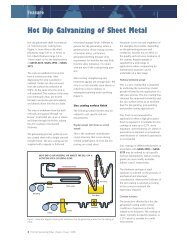Fasteners - hdgasa
Fasteners - hdgasa
Fasteners - hdgasa
Create successful ePaper yourself
Turn your PDF publications into a flip-book with our unique Google optimized e-Paper software.
Bob’s Banter<br />
Natural networking can achieve a sustainable business organisation<br />
Published in the Sunday Independent:<br />
A ‘system’ is defined by its structure, its<br />
pattern of organisation and the process<br />
that it is involved in. For example, a motor<br />
car is characterised by a body, wheels and<br />
engine (structure); by its particular design<br />
(organisation) and by the way it generates<br />
power to serve as a means of transport<br />
(process).<br />
In the 1970s, two Chilean biologists,<br />
Humberto Maturana and Francisco Varela,<br />
defined a ‘living system’ as one where the<br />
pattern of organisation is a very special<br />
type of network. According to their theory,<br />
which is called ‘autopoiesis’ (‘selfmaking’),<br />
each component of the system<br />
must participate in the production or<br />
transformation of other components. In<br />
this way the network continually makes<br />
itself. The network is produced by its<br />
components and in turn produces those<br />
components. Autopoiesis is now being<br />
referred to as the ‘pattern of life’ and is<br />
providing the basis for the new emerging<br />
theory of the process of life.<br />
A living system can be both open and<br />
closed: it is structurally open (matter can<br />
be added or removed) but organisationally<br />
closed (the system maintains a stable and<br />
autonomous form). A characteristic of a<br />
living system is thus the paradoxical<br />
coexistence of change and stability.<br />
The autopoietic pattern of organisation<br />
assumes that the network knows what it is<br />
doing; i.e. it has knowledge and learning<br />
capabilities. Being autonomous and selforganising,<br />
the network must collect and<br />
process all its own information from the<br />
environment.<br />
A living system is characterised by<br />
continual flow of material through it<br />
and continual change. In many<br />
metabolic systems in nature thousands<br />
of chemical reactions occur each<br />
second. Living systems maintain<br />
themselves in a state far from<br />
equilibrium. The only living system that<br />
is at a state of equilibrium is a dead<br />
one!<br />
Fritjof Capra (The Web of Life) has used<br />
the modern theory of the process of life to<br />
develop a unified understanding of the<br />
complexity and diversity of nature.<br />
Although perhaps not as rigid, the new<br />
theory can also be applied to business<br />
management. It is becoming increasingly<br />
evident that human beings have a lot to<br />
learn from nature. The inclusion of<br />
biologists as company directors may not<br />
be too distant!<br />
As in living systems, businesses must<br />
continually generate configurations that<br />
are constantly new. Change, as in reengineering,<br />
should not be a special event<br />
in a company’s history but an ongoing<br />
integral process. Change and stability are<br />
not mutually exclusive.<br />
Divisions, departments and sections in an<br />
organisation should be interconnected<br />
and interdependent. There is no ‘silo’<br />
mentality in a living system. The essential<br />
properties of the company, i.e. its<br />
competitiveness and value, should arise<br />
from the relationships between its parts,<br />
not from any of the individual parts. A<br />
company should be viewed as an<br />
organised complex structure where the<br />
whole is greater than the sum of its parts.<br />
The relationships form the network, which<br />
in living systems is the process of life. In<br />
businesses, the network may be the<br />
process of success.<br />
Feedback is an essential part of a network.<br />
In living systems, feedback is firmly<br />
embedded in the organisational pattern<br />
and is part of the self-regulatory<br />
mechanism. Similarly in business, internal<br />
feedback should be an integral part of the<br />
management process.<br />
The process of life is identified with the<br />
process of knowing. So too for business.<br />
Knowing is broader than thinking, as<br />
knowledge implies action and results. The<br />
main source of information is from<br />
interacting with the environment. The<br />
system/company can couple with the<br />
environment to facilitate the transfer of<br />
information but must maintain autonomy.<br />
The environment may trigger changes but<br />
does not specify or direct them. If<br />
businesses follow living systems they will<br />
realise that their destiny is in their hands,<br />
not those of competitors or market forces.<br />
Companies should not strive for<br />
equilibrium. Having a stable product or<br />
technology in a seemingly stable market, a<br />
complacent workforce and rigid processes<br />
means that the company may be close to<br />
extinction. Stretched targets and<br />
objectives, challenges on employees and<br />
constantly improving technology will<br />
move the company away from a state of<br />
equilibrium. As with living systems,<br />
companies will thrive and prosper in these<br />
conditions.<br />
There are many differences between<br />
biological and human systems. We can<br />
learn little from living systems about the<br />
human personality, but we can learn a<br />
great deal about organisation and<br />
sustainability.<br />
The Association wishes to thank Bob Andrew who<br />
is a consulting value engineer and honourary<br />
member of the Association for his article. He can<br />
be contacted on anneve@iafrica.com or<br />
boband@mweb.co.za.<br />
24 Hot Dip Galvanizing Today Volume 10 Issue 2 2013


